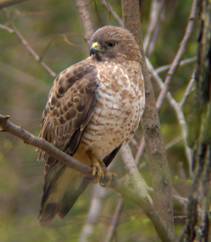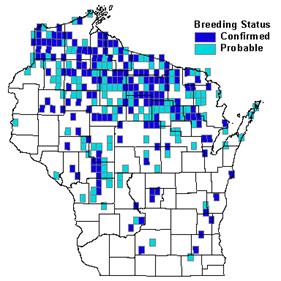Photo by Ryan Brady


Status/Protection
- Global Rank: G5 Key to global and state ranks
- State Rank: S5B
- WBCI Priority: PIF
Population Information
The Federal BBS information can be obtained at http://www.mbr-pwrc.usgs.gov/bbs/bbs.html by clicking on Trend Estimates and selecting the species in question. All estimates are for time period (1966-2005).
*Note: There are important deficiencies with these data. These results may be compromised by small sample size, low relative abundance on survey route, imprecise trends, and/or missing data. Caution should be used when evaluating this trend.
- Federal Breeding Bird Survey: significant increase
- Federal Breeding Bird Survey (WI): non-significant decline
- Federal Breeding Bird Survey (BCR 23): stable*
- Federal Breeding Bird Survey (BCR 12): non-significant increase
- WSO Checklist Project: decline (1983-2007)
Life History
- Breeding Range: Central Alberta east across southern Canada and the eastern U.S. states to the Atlantic Coast (Goodrich et al. 1996).
- Breeding Habitat: Northern Hardwood, Oak, Aspen, White Pine, Hemlock Hardwood.
- Nest: Platform, located in lower third of canopy (Goodrich et al. 1996).
- Nesting Dates: Eggs: early May to late June (Robbins 1991).
- Foraging: Swoops (Ehrlich et al. 1988).
- Migrant Status: Neotropical migrant.
- Habitat use during Migration: Few data, but migrants roost in wooded areas (Goodrich et al. 1996).
- Arrival Dates: Late March to mid-May (Robbins 1991).
- Departure Dates: Mid-August to early October (Robbins 1991).
- Winter Range: Southern Florida; Central and South America (Goodrich et al. 1996).
- Winter Habitat: Mature tropical forests to second-growth forests (Goodrich et al. 1996).
Habitat Selection
The Broad-winged Hawk is associated with a wide variety of forest types including dry to wet deciduous, mixed or occasionally coniferous forests (Bent 1961, Johnsgard 1990). In Wisconsin it commonly nests in older mesic forests (Hoffman 1989) and upland deciduous forests including oak-aspen or aspen-birch stands (Keran 1978, Rosenfield 1984). The average stand density at Broad-winged Hawk nest sites in Wisconsin was 204 trees per hectare (Keran 1978) and average diameter at breast height (DBH) of nest trees was 31.5 cm (Rosenfield 1984). Nest sites were typically within 124 m of an upland opening and 143 m of a wetland (Keran 1978), which may serve as foraging habitats (Keran 1974). Although other studies also have reported nesting close to some type of forest opening (Titus and Mosher 1981, Rosenfeld 1984), the importance of this habitat variable seems to vary by region. For example, Broad-winged Hawk nests in western New York were noticeably farther from forest openings than other studied populations (Crocoll and Parker 1989). Nests are placed in a lower crotch of a tree (Keran 1978) and are usually >1 km from the nearest neighboring nest at Wisconsin sites (Rosenfeld 1984). Nest densities vary by region and forest type but measured 1 pair/2.4 km2 in the aspen-birch forests of Wisconsin, where nest success was 79% (Rosenfeld 1984).
Habitat Availability
Robbins (1991) classified the Broad-winged Hawk as a common summer resident north of Polk, Chippewa, Marathon, and Oconto counties. More recent data from the Wisconsin Breeding Bird Atlas reveal a wider distribution, including breeding records from southeastern and western regions of the state (Rosenfield and Bielefeldt 2006). It occurs sparingly in the upland wooded areas of western Wisconsin south to Monroe and Sauk counties (Robbins 1991). The northern mesic forest commonly used by Broad-winged Hawks covers the largest acreage of any Wisconsin vegetation type. However, it has been significantly altered from presettlement conditions. Virtually the entire forest was logged prior to 1930, causing subsequent changes in forest composition. Today, forests of aspen, white birch, and red maple have replaced forests dominated by sugar maple, basswood, hemlock, and white pine in many areas (Hoffman 1989). However, it is not clear what impact the compositional changes have had on Broad-winged Hawks since they successfully breed in these aspen-dominated forests (Rosenfeld 1984).
Population Concerns
The Broad-winged Hawk may be the most abundant of the North American hawks(Johnsgard 1990). Breeding Bird Survey (BBS) data indicate a significant annual increase range-wide but data for Wisconsin suggest population declines (Rolley 2005, Sauer et al. 2005). However, BBS routes may not adequately sample this species (Goodrich et al. 1996). In Wisconsin it is a common summer resident in the north and an uncommon summer resident west and central (Robbins 1991). During the six-year period of the Wisconsin Breeding Bird Atlas, observers documented breeding activity in nearly 40% of the surveyed quads and confirmed breeding in 14% (Rosenfield and Bielefeldt 2006). As in much of eastern North America, the Broad-winged Hawk is an abundant migrant in Wisconsin (Robbins 1991). Thousands of individuals may be seen in a single September day along the Lake Michigan shoreline (e.g., Cedar Grove Ornithological Station, Sheboygan County) with smaller but significant concentrations along Wisconsin’s south shore of Lake Superior during late April and May (Brady 2000). At Hawk Ridge Bird Observatory near the northwestern border of Minnesota and Wisconsin, Broad-winged Hawks are typically the most abundant migrating raptor. Counts of tens of thousands of individuals have been documented in a single day.
Limiting factors of the Wisconsin Broad-winged Hawk breeding population are not well-studied. Elsewhere in its range, prey abundance and competition with other raptors may limit breeding density and human development, especially near lakefront areas, may stress nesting birds (Armstrong and Euler 1983). Pollution impacts on local amphibian prey also may be detrimental to the Broad-winged Hawk (Goodrich et al. 1996). Habitat loss, fragmentation, and increased use of DDT on the wintering grounds also are serious threats (Goodrich et al. 1996).
Recommended Management
At the landscape level, manage for a variety of forest age classes including mature and old forest. At the stand level, Grimm and Yahner (1985) suggest the following recommendations for management of Broad-winged Hawks in Pennsylvania, which likely would also be applicable in Wisconsin:
- develop total overstory densities of at least 530 trees/ha with >50% of the trees 20 cm DBH;
- maintain stands with basal areas of at least 26 m2/ha with some trees at least 27 cm DBH and 19 m tall;
- maintain stands with 40-45 ha of total forest cover and 20 ha of coniferous or mixed forest cover within 0.8 km; and
- designate conservation areas for this species that are at least 0.8 km from cropland or human development.
Other recommendations include preserving forest patches for roosting along major migration routes (Goodrich et al. 1996) and public education regarding the importance of private woodlands for nesting and migrating raptors (Castrale 1991).
Research Needs
Research is needed to design and validate population survey methods for Broad-winged Hawks and other woodland raptors (Titus et al. 1989). Limiting factors of the Wisconsin population need more study. Studies that investigate home-range size and minimum forest size for stable populations also are needed. During the winter months, distribution, habitat requirements, survivorship, and effects of forest fragmentation remain poorly known (Titus et al. 1989, Goodrich et al. 1996).
Information Sources
- Boreal Songbird Initiative species account: http://www.borealbirds.org/birdguide/BD0097_species.shtml
- Chequamegon National Forest Bird Survey (NRRI) species account: http://www.nrri.umn.edu/mnbirds/accounts/BWHAa2.htm
- Conservation Assessment for Broad-winged Hawk: http://www.fs.fed.us/r2/blackhills/projects/planning/assessments/broad_winged_hawk.pdf
- Cornell Lab of Ornithology Species Account: http://www.birds.cornell.edu/bfl/speciesaccts/brwhaw.html
- Illinois Raptor Center species account: http://www.illinoisraptorcenter.org/Field%20Guide/broad.html
- Hawk Mountain species account: http://www.hawkmountain.org/education/broadwing.htm
- Patuxent Bird Identification Center: http://www.mbr-pwrc.usgs.gov/id/framlst/i3430id.html
- Wisconsin Breeding Bird Atlas http://www.uwgb.edu./birds/wbba/
References
- Armstrong, E. and D. Euler. 1982. Habitat usage of two woodland Buteo species in Central Ontario. Canadian Field-Naturalist. 97:200-207.
- Bent, A.C. 1961. Life histories of North American birds of prey. Vol. 1. Dover Publications, Inc. New York.
- Brady, R. Chequamegon Bay raptor migration: a summary of the spring 2000 season. Passenger Pigeon 62:250.
- Castrale J.S. 1991. Eastern woodland buteos. Pp. 50–59 in Proceedings of the Midwest Raptor Management Symposium and Workshop (B.G. Pendleton, D.L. Krahe, M.N. LeFranc, Jr., K. Titus, J.C. Bednarz, D.E. Andersen, and B.A. Millsap, eds.). National Wildlife Federation, Washington, D.C.
- Crocoll, S.T. and J.W. Parker. 1989. The breeding biology of Broad-winged and Red-shouldered hawks in western New York. J. Raptor Res. 23: 125–139.
- Ehrlich, P.R., D.S. Dobkin, and D. Wheye. 1988. The birders handbook: a field guide to the natural history of North American birds. Simon & Schuster, Inc. New York.
- Goodrich, L.J., S.C. Crocoll, and S.E. Senner. 1996. Broad-winged Hawk (Buteo platypterus).
- In The Birds of North America, No. 218 (A. Poole and F. Gill, eds.). The Academy of Natural Sciences, Philadelphia, PA, and the Amercan Ornithologist’ Union, Washington, D.C.
- Grimm, J.W. and R.H. Yahner. 1985. Status and management of select species of avifauna in Pennsylvania with emphasis on raptors. Final Report to the Pennsylvania Game Commission.
- Johnsgard, P.A. 1990. Hawks, eagles, & falcons of North America: biology and natural history. Smithsonian Institution Press.
- Keran, D. 1978. Nest site selection by the Broad-winged Hawk in north central Minnesota and Wisconsin. Raptor Research 12: 15-20.
- Keran, D. 1981. The incidence of man-caused and natural mortalities to raptors. Raptor Research 15:108-112.
- Robbins, S.D., JR. 1991. Wisconsin birdlife, population and distribution, past and present. University of Wisconsin Press, Madison, WI U.S.A.
- Rolley, R. Wisconsin Checklist Project. http://dnr.wi.gov/org/land/wildlife/harvest/reports/07checklist.pdf
- Rosenfield, R N. 1984. Nesting biology of Broad-winged Hawks in Wisconsin. Raptor Research 18: 6-9.
- Rosenfield, R.N. and J. Bielefeldt. 2006. Broad-winged Hawk. In Atlas of the Breeding Birds of Wisconsin. (N.J. Cutright, B.R. Harriman, and R.W. Howe, eds.) The Wisconsin Society for Ornithology, Inc. 602pp..
- Sauer, J.R., J.E. Hines, and J. Fallon. 2005. The North American Breeding Bird Survey, Results and Analysis 1966 - 2005. Version 6.2.2006. USGS Patuxent Wildlife Research Center, Laurel, MD.
- Titus, K., M.R Fuller, D.F. Stauffer, and J.R. Sauer. 1989. Buteos. Pages 53-64 in Proceedings of the northeast raptor management symposium and workshop (B. Pendleton, M. LeFranc, and B. Millsap, eds.). National Wildlife Federation Scientific and Technical Series No. 13.
Contact Information
- Compiler: Dan Haskell, danhaskell@hotmail.com
- Editor: Kim Kreitinger, K.Kreitinger@gmail.com | Ron Eckstein, Ronald.Eckstein@Wisconsin.gov
